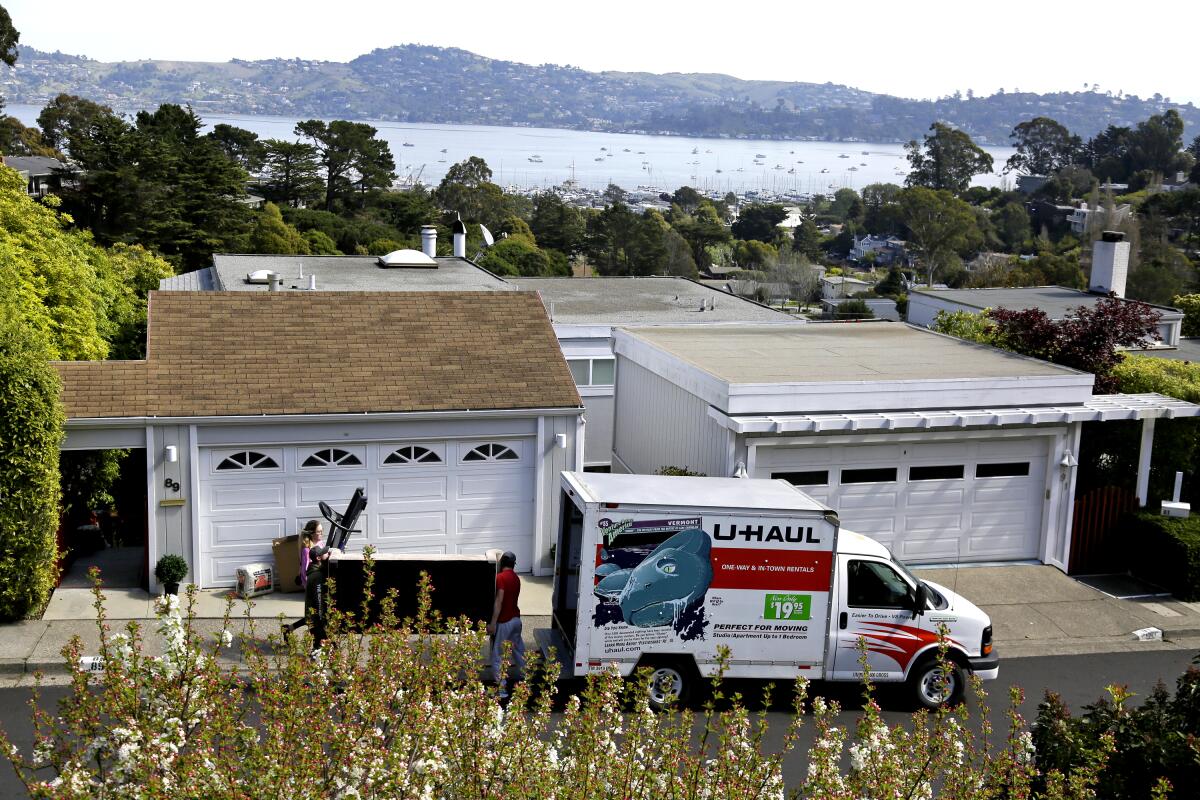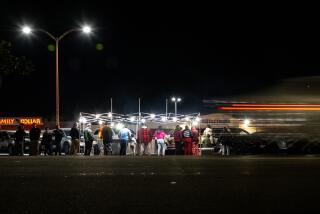Op-Ed: Why more Americans should leave home and move to other states

- Share via
America has been lazily divided by pundits into red and blue states, as if there weren’t constant movement of people between them. Fortunately, reality is a lot more purple — and hopeful — as immigrants, people of color and millennials reshape parts of America by voting with their feet and moving.
These demographic groups are migrating from the big coastal cities to the suburbs, the interior cities, the South and even parts of the Midwest. And in the process, these newcomers change both their new homes and are also changed by them.
Throughout most of the last century, the migration of Black Americans and immigrants was largely to the big cities of the Northeast, and, in the later decades, to the West Coast as well. Yet over the last decade there has been an accelerating shift of these populations out of those traditional havens to locales that have seen relatively little in-migration in the past.
In his analysis for Heartland Forward, a nonprofit research group, demographer Wendell Cox found that among the largest metropolitan areas, the fastest growth in the foreign-born population over the last decade took place in Dallas, Houston, Nashville and Columbus, Ohio, where their numbers went up between 25% and 40%. In contrast, foreign-born populations are either stagnating or dropping in Los Angeles, New York and Chicago, the nation’s traditional immigrant centers.
Ironically, the fastest growth has taken place in the states that supported Donald Trump while declining in those that supported Hillary Clinton in 2016. Rather than cluster in a few places, immigrants are increasingly following the earlier patterns of the 19th century, spreading out into the middle of the country.
This movement is already transforming and reenergizing some regions in surprising ways. Nashville may be the country music capital — stereotyped as the epitome of white American culture — but it is also home to a Little Kurdistan, a Somali population and a growing Latino community. Even a place like Fargo, N.D., which was more than 90% white in 1990, has seen newcomers and more foreign-born residents create a more diverse city. When I was there in the summer I happily stumbled upon a Thai ice cream parlor.
A similar pattern of movement away from traditional hubs can be seen among African Americans. Black populations are stagnant or even declining in places such as New York, Los Angeles, Seattle and Portland, Ore. In the city of San Francisco, the African American community has declined from 13% in 1970 to roughly 5% today. Although that community dates to the 19th century, it has become so small that there’s even a 2019 movie called “The Last Black Man in San Francisco.”
So where are African Americans headed? Places such as Atlanta, Salt Lake City, Phoenix and Las Vegas, as well as a host of smaller metro areas such as Boise, Idaho; Fayetteville, Ark.; Provo, Utah; Portland, Maine; and Scranton, Pa. For African Americans and other minorities, the prime motivation seems to be economics, as shown in a recent report for the Urban Reform Institute.
Median household income for African Americans in Atlanta, adjusted for cost of living (in which housing costs are a big component), was more than $60,000, compared with $36,000 in San Francisco and $37,000 in Los Angeles. The real household median income for Latinos is more than $65,000 in Columbus and St. Louis, compared with $43,000 in Los Angeles, $47,000 in San Francisco and $40,000 in New York.
One critical economic factor is homeownership. Property remains key to financial security: Home equity accounts for roughly two-thirds of the wealth of middle-income Americans, according to the Census Bureau. Yet in some parts of the country, notably coastal California and the Northeast, homeownership is often out of reach. Some 50% of Black residents own their homes in places such as the Atlanta and Oklahoma City metro areas compared with barely one-third in the metro areas of Los Angeles and Denver. Among Latinos, El Paso and St. Louis stand out as high homeownership metro areas, while homeownership is much lower in Boston and San Jose.
Even before the pandemic, the Brookings Institution noted, millennials were already leaving big cities such as New York, Los Angeles and Chicago and headed toward less expensive metro areas such as Dallas-Fort Worth, Austin and Houston. The pandemic — in part, by allowing people to work remotely — has further hastened the move among younger tech workers from San Francisco, New York, Boston and Chicago to places such as Sacramento, Madison, Wis., and Cleveland.
The movement of socially liberal millennials, minorities and immigrants is seen by some progressives as a way to build a permanent Democratic majority in parts of the country that lean conservative. This certainly could be seen in the Georgia Senate races, where African American and Latino voters helped push two progressive Democrats, Raphael Warnock and Jon Ossoff, to victory.
Conservatives fear that left-oriented newcomers will overturn the politics of their strongholds. But we should also consider the potential long-term effects when historically marginalized people are able to buy homes and start businesses. In the past, these changes tended to make people somewhat more conservative.
In Texas, where Latinos generally do better economically and are more able to buy homes than in California or New York, they also tend to split their votes more evenly between the parties, with almost 40% voting for Trump.
Even in big cities such as New York, Trump managed to improve performance in minority and immigrant neighborhoods, perhaps in part a reaction against the disproportionate effect of COVID-19 restrictions on businesses that employ more workers of color. American communities, according to a new study by The Times and the Reality Check Insights polling firm, are largely more middle of the road than their representatives, with moderates being the biggest group in cities, rural areas and suburbs across the country.
This movement toward centrist politics through migration potentially offers a way out for our toxic and highly polarized political environment. These demographic trends, which are unlikely to go away, may turn out to be the unifying force the country needs.
Joel Kotkin is the presidential fellow in urban futures at Chapman University and executive director of the Urban Reform Institute. He is the author of “The Coming of Neo-Feudalism.” @joelkotkin
More to Read
A cure for the common opinion
Get thought-provoking perspectives with our weekly newsletter.
You may occasionally receive promotional content from the Los Angeles Times.










